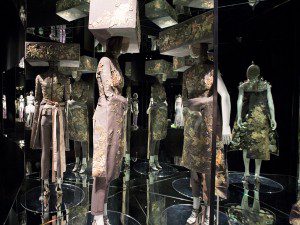The word process crops up in art speak so often it can easily become detached from its literal meaning. This is not the case at Carroll / Fletcher who use the notion of an action set in motion to connect the notion of craft to the art of the information age. It is pretty rare to find net.artists, or post-internet artists, displaying much sympathy for the medium of drawing – a positively 19th century activity to most – however several artists here do re-connect the graphic to the algorithmic by dwelling on what the drawn line shares with technology – the power of process.
Pencil / Line / Eraser takes its title from a work by gallery artists John Wood and Paul Harrison in which a pencil line drawn with one hand is simultaneously erased by another. The video playfully imparts into a simple task some weighty philosophical and psychological ideas about erasure and the destructive nature of creativity. It also reminds us of what we lose when we create new technologies, a prescient topic in light of our current anxieties about privacy and surveillance. Despite all that it is hard to escape the feeling that this is a show cobbled together around a concept rather than an intuitively led investigation which, in its solo shows, the gallery is especially good at presenting.
This exhibition is the first to be distributed across the main gallery on Eastcastle Street and Carroll / Fletcher’s new Project Space on nearby Riding House Street. In the main space the stand out work is by Julius von Bismarck. The young descendent of the grandfather of the German state has created a machine which narrates a book (kept secret by the artist) via an algorithm that illustrates sentences through a selection, and then drafting, of patent drawings. By using the USA’s patent database as its vocabulary, Bismarck literally illustrates how a list of inventions creates its own historical record, reflecting world events through the register of technological innovation.
The bulk of the work, however, is mostly dispiriting. The parody of the digital via the handmade often falls foul of the high standards many of these artists commonly set themselves. Paul Wood and John Harrison are particularly culpable in this respect. The three works they show in addition to the titular video (variations on photocopier produced animations), are conceptually two dimensional and feel like the kind of design you might see in a self-consciously “kooky” TV advert.
The cool detachment that, perhaps inevitably, pervades the show is punctured by the work of Christine Sun Kim. Deaf since birth, Kim knows her subject only in the negative; its contours rather than its centre. She is incredibly concerned with the ownership of sound and her barbed paper drawings inject such much needed chutzpah into the Project Space’s basement. The other highlight on Riding House Street is a seismograph by Rafael Lozano-Hemmer that responds to visitors vibrations (however you choose to create them). In a small act of technographic alchemy, the machine turns the reverberations into portraits of an anonymous 11th century Italian philosopher.
It has to be said though, this is very much a summer group show. The purpose of these projects is to provide the gallery with some respite before the serious autumn programme kicks in. In such circumstances it would be rash to judge this show too harshly. It falls short of its ambition and compares poorly to the gallery’s normally exceptional standards. Perhaps it would best be considered an eminently forgivable drawing board idea.
Pencil / Line / Eraser, until 13 September, Carroll / Fletcher, 56 – 57 Eastcastle St, London W1W 8EQ.
Ivan Knapp
Credits
1. A Kassen, Flatten image #10, 2011, Photograph, glass and custom made frame 204 x 137 cm. Courtesy of the artist and Carroll/Fletcher.
Follow us on Twitter @AestheticaMag for the latest news in contemporary art and culture.





